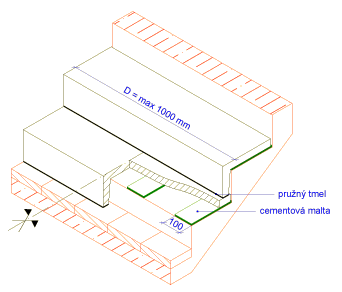Technical conditions for laying stairs
Technical conditions for mounting the stairs It is recommended that you carry out the steps of the staircase by a specialist company who knows the artificial stone system (based on DIN 18333 - Artificial stone work) and uses the following principles for the installation of terrazzo stairs and window sills.
Prior to installation, we recommend that the pallets of the terrazzo elements on the site be opened before gluing = removing the cover sheet.
Such unpacked pallets should be stored for about 3-4 days there. At this time tempering of terrazzo elements and compensation of the amount of bound water in terrazzo element occur.
If the elements immediately after unpacking the pallet are glued to a concrete substrate, due to the different moisture on the surface of the terrazzo element, it is possible that the rapidly drying surface shrinks and the terrazzo element is bending. This defect is not a production of terrazzo elements but a mounting error.
Each concrete product expands with heat change. Therefore, it is necessary to comply with the following principles for proper instalation and proper operation:
- Both the stairś cladding and the window sill must not be firmly attached (it must have the possibility of longitudinal thermal expansion)
- Both the stair´s cladding and the parapet board must be laid with a gradient of at least min. 1%% forward to ensure water flow.
- A gap must be left between the stair´s cladding or the window sill and the fixed point (railing, wall, closed staircase) - inside the building about 2mm, outside the building about 5mm - fig.2.
- Both the stair´s cladding and the window sill are laid in the area of tread on mortar strips according to Fig. 1, 3. Mortar for outdoor stairs must be frost-resistant. The angle stair treads are not rubbed and there is an air gap between the stair´s tread and riser.
- The substrate must be cleaned of grease and coarse impurities, must not be crumpled or frozen. Stair treads can be done at an outside temperature above 5 ° C.
- For jointing, cement mortar or grout is used. For outdoor stairs, the grout must be frost-resistant.
Examples of installation of window sills and stairs´claddings:

Fig. 1Fig. 1 Instalation of stairs up to 1m

Fig. 2Fig. 1 Instalation of stairs up to 1m

Fig. 3Fig. 3 Dilation of the stair´s element by the wall
Final surface finish before proper use
Terrazzo stairs and sill boards must be impregnated after installation before use (most often after general building clearance, before using the staircase for normal use). This impregnation closes the surface of the terrazzo product, reduces its water absorption and the possibility of fouling of soil into surface pores - reduces the cost of regular cleaning and also highlights the drawing of the aggregate.
Prior to impregnation, the stair and sill surfaces must be properly cleaned. Coarse dirt is removed mechanically - be careful of damage to the surface of the product by scratching with hard materials. Any lime efflorescence or cement or mortar polution is cleaned with cement sludge and effluen removal. Immediately after use of chemicals, the surface must be properly cleaned with clean water. After the surface has dried, the impregnation agent's instructions are to impregnate the surface or fluent the surface of the product. This prevents moisture and dirt from entering the surface layer.
